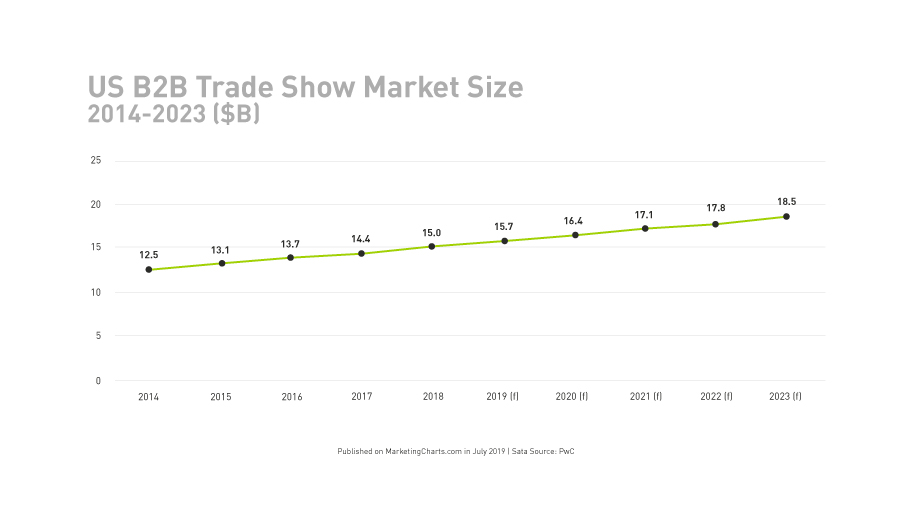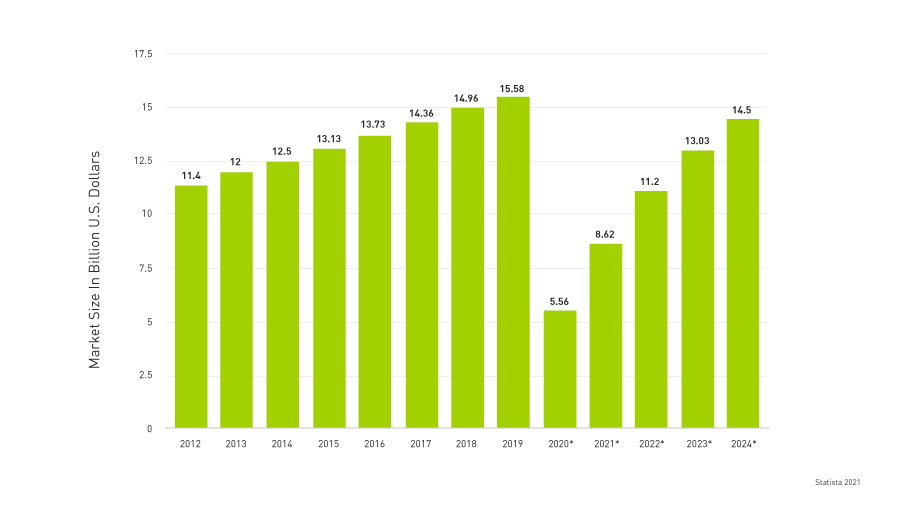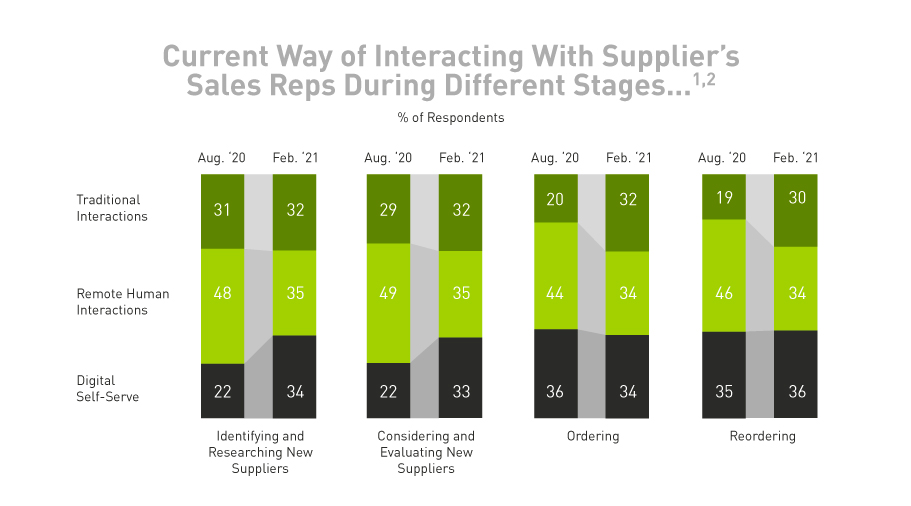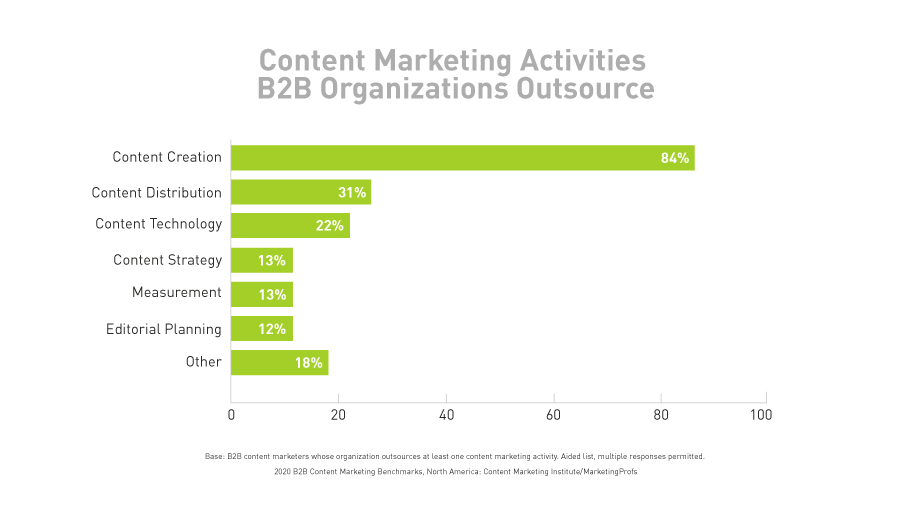According to the Center for Exhibition Industry Research, there were roughly 9,400 business-to-business trade shows in the U.S. in 2019. These trade shows by some estimates represented a $15 billion industry that was forecast to exceed $17 billion in 2021. More importantly, these shows routinely represent critical sales opportunities for businesses of all sizes.
Then in 2020, the “Rona” came and not only wiped out the shows, but also the critical sales opportunities they offered. The climb back to trade show “normalcy” is predicted to be slow as shows and businesses scramble for virtual solutions to bridge the gap.
 Tradeshow revenues in Billions – Statista 2021
Tradeshow revenues in Billions – Statista 2021
But what does that mean for the sales and marketing people who have depended on trade shows to hit their numbers? In today’s edition of Plain Talk, we’ll discuss the past and future of the trade show and talk about whether the trade show of today, or tomorrow, will still be your business Super Bowl.
Size Matters
So first, a quick example. If you work in the construction industries, you know that CONEXPO-CON/AGG is North America’s largest B2B construction trade show. It is held every three years at the Las Vegas Convention Center and the record 2017 show had 2,800 vendors spread out over 2.8 million square feet and was attended by 128,000 people. That’s a space larger than the entire Empire State Building with ten times more people than the legendary skyscraper holds. That’s a big show. Last March, the 2020 CONEXPO was cut short by one day due to COVID-19’s onset. Roughly 2,000 exhibitors attended and just as many cancelled in the days and weeks leading up to the show. Roughly 130,000 attendees registered, but a fewer number than that actually showed up. Ultimately, the show ended a day early as the country officially shutdown on March 13, 2020.
However, the 2023 CONEXPO-CON/AGG website is up and is already announcing 2.7 million square feet of exhibit space – almost as much as its 2017 record. The question companies in the construction industries are asking about CONEXPO-CON/AGG, is the same one you might be asking about your industry’s largest trade show – “Is it still our Super Bowl?” If trade shows were critical to your business before COVID-19, they should be again, but likely in an evolved way. The CONEXPO example, while extreme, is a great reminder of how trade shows can offer scale to customers and sales folk in a unique way.
Abrupt And Disruptive
It’s unlikely any company planned 2020 with pandemic contingencies in place when they were budgeting and setting sales goals. Every company had to react on the fly to minimize damage to their business, and just as importantly, to make sure their customers were taken care of. A staggering 50% of sales professionals reported an increase in workload due to the pandemic versus only 2% that reported a decrease. So, despite working from home and not traveling, salespeople have been working harder than ever to maintain the status quo. Much like a highway detour, salespeople have been figuratively redirected to the sideroads, making progress tougher and slower. We think that when the “highway” opens back up, the smart salespeople will be the first to find the access ramps, but before you hit the gas, there are a few things worth considering.
Business Is Personable
People buy from people and companies they trust and like, and salespeople and buyers are seldom strangers. In many diverse industries and for many companies, trade shows have long been where companies across the supply chain meet, technologies are revealed, and business gets done.
However, COVID-19 is one of those once-in-a-lifetime events that can change the way business is done, so it’s critical to understand if or how the pandemic has changed each of your customers so you can grow or maintain your business relationships. Part of this check-in will be to be aware of your own bias and if or how the pandemic has changed you while getting a grip on any new customer preferences. For example, your client may love to travel and thrive with in-person, face-to-face relationship building that has always been part of his or her business process, or they may be the client who would be really happy to never take another business trip to Vegas again. If they are the latter, then changes in the sales process, like virtual trade shows, Zoom meetings and enhanced web services, may have been a good deal for them. For you to be successful, you will need to have an understanding of any changes to client preferences and to adjust your approach to meet them.
One efficient way to get honest feedback from clients is to deploy an online Customer Satisfaction Score (CSAT), or survey. You are probably already doing this (if not, you are missing out) so including questions about satisfaction with your interim sales interactions like enhanced web self-service features will be easy to add. This will help you develop a better account-based marketing (ABM) approach for each customer and free you up to give more time to the customers who strongly prefer face-to-face contact.
Meeting Again
Once you have a grip on client satisfaction and preferences, it’s time to get back to work. As we indicated above, there have been some changes in customer behavior. Research from McKinsey Global Institute shows that while customer product research and evaluation activity is rapidly shifting to “digital self-serve” methods, the actual ordering and reordering of products are just as rapidly shifting back from “remote human interactions” to “traditional interactions.” The implications are that while customers appreciate being empowered to control the vetting process digitally, there remains a place for in-person transactions and relationships.
Back and Big but Better Integrated
While these trends are powerful, how do they extrapolate post-pandemic? Your company and likely most of your competitors upped your online game during the past year. In lieu of events and travel, your website has likely been enhanced with video, animation, graphs, charts, data sheets and articles about your products. Your user experience (UX) has been improved. A buyer’s ability to research and evaluate products in 2021 has increased. Your social media presence has likewise probably been ramped up. It should be no surprise that of the 50% of B2B organizations that report outsourcing some of their content marketing, content creation is what they outsource the most at 84%.
When trade shows are back, you can expect that content investment to pay off in the form of a shorter purchase funnel and a more knowledgeable customer who better understands your products and those of your competitors. To prepare for this, plan to:
1. Know where they’ve been. Conduct a thorough study of what content your customers have been reading and what else you think they can benefit from knowing about your products. Your customer relationship management (CRM) data should be able to provide you with this information. This will help you focus your efforts where needed and squeeze tons of efficiency out of every meeting.
2. Pregame. Given the increased openness to content marketing, up your pregame in two ways. First, hit your existing contacts with any relevant content they have not yet viewed. While you’re at it, make sure to work your trade show schedule into your email and social media content marketing. Second, get the attendee list. If you need to pay for it, this is the year to suck it up and work it into your budget. If you can get the list, de-duplicate it against your existing CRM list and hit them with your best and most relevant content along with show-related information. Finally, now that you can finally be together in person, reach out early to get on the calendars of high-value attendees. Some of these customers haven’t seen you in over a year. Buy them a steak.
3. Time your releases. If you haven’t timed your product releases in the past with major trade shows, start now. Your trade press and many of your top customers are all staying overnight within ½ a mile of your new products, top salespeople, senior management and public relations team. Make that work for you. Also, since the customer has digitally researched you, give them something new they haven’t seen and researched.
4. Staff smarter. Your customers will be coming to your booth smarter about your product. Expect harder questions. The interns and junior marketing people aren’t who should be answering questions. Put your product knowledgeable people up front.
5. Enhanced attribution. In the last year, the world got a lot more digital. If you are planning to return to events, your trade show attribution model needs to be addressed. Look at how you recognize and identify the people you come in contact with at the trade show in your CRM. Pregaming correctly (step 2 above) should make this easier. You need to have a way of recording your interactions in your CRM scoring system, so that you can show how the trade show advanced key customers in your sales funnel and ultimately contributed to more sales. Accounting has a right to know.
Are You Ready?
So will trade shows be your Super Bowl again? Assuming your biggest trade show in the past was your Super Bowl, it likely will be again. COVID-19 didn’t kill that, but to maximize the value of trade shows and non-trade show business development activity, now is the time to determine if your customers’ preferences have changed when we were all working from home in our basements, home offices or kitchen tables. During that time, your customers weren’t hibernating, they were evolving. Prepare for smarter show attendees that are further along in their sales process thanks to digital tools, and treat them as such. Follow that game plan and you’ll likely come home from the big show with some big sales!
Need A Coach?
If you have any questions about the changing trade show landscape or how you can maximize your place in it, give us a call at 502-499-4209, or drop us a line and we’ll be happy to answer any questions.






